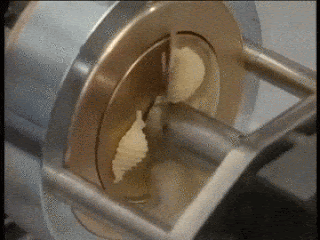If you grow your own maters, you know that quite often you are faced with some big green ones. Yes, you can wait for them to ripen, but why not pick them now, and make yourself a special treat-
Fried Green Tomatoes. Yes, they are real, not just the title of a movie. And you don't have to go down south to have them. Although you can't find green tomatoes at the supermarket, you can ask for them at your local farm market or stand. (or your neighbor's garden)
Fried Green Tomatoes are easy to make, but do require some prep time. Wash them, then slice them. Not too thinly, though, or they will turn to mush when you cook them.
Then you need to set up what we in the business call the dredging station. Flour, egg, crumb. I use King Arthur Flour, but that's a story for another day, another post. I don't season my flour. I season the egg. I use sea salt, pepper and chopped basil in my egg mix. When you bite into the tomato, you get that little surprise of basil flavor. The bread crumbs are just plain. No seasoned, and no Panko crumbs here. Here's what the setup looks like:
Now here's the big secret about dredging: Use one hand for the wet, and one for the dry. So, here's how I do it. I pick up a tomato slice with my left hand and put it into the flour. With my right hand, I sprinkle some flour on the top, then flip it over so both sides are coated with flour. I pick it up with my right hand, then place it into the egg mix, being careful not to get my fingers in the egg. Using my left hand now, I flip the slice to coat it with egg, then pick it up and place it into the crumbs, again, attempting to not get crumbs onto my eggy fingers. Right hand now- put some crumbs on the top, then flip it over to get all coated with crumb, then gently put onto a waiting tray or plate. If you're lucky, you can get all of your tomatoes breaded without forgetting which hand is wet, and which is dry. Yeah, good luck with that. Most likely, you'll have goop stuck to both hands. It's all good. No judgement here. Remember, it's just food.
Now, it's time to fry. And by that, I mean pan fry, not deep fry. If you have a cast iron pan, now's the time to break that sucker out. They heat so evenly. They're wonderful. Unfortunately, mine is not big enough for this task. I would be frying for hours, so I used my super duper nothing sticks to me I got it on the internet pan. I use grapeseed oil to fry. It heats nicely, and has no taste. You can use an olive oil if you want, but not extra virgin. It will smoke if you get it too hot and turn bitter on you. Save it for drizzling over the tomatoes when they're done, if you want the flavor. As for canola oil, well, read my post about that. Blechhhh.
Let them get nice and brown and crispy. If you are making a bunch of them, you can reheat them right before you serve. But not for too long. You want them to stay a little crunchy on the inside.
As for serving them, well, there are myriad ways. You can do a mayo/aioli type sauce, a drizzle of good olive oil and aged balsamic, or pretty much anything else. I had some really nice, locally made fresh mozz in the fridge, so I sliced it and layered it between the tomatoes, then drizzled with some homemade pesto. It could have been a meal in itself, but I used them as a side for our Beyond burgers. I think I'll write about them next...
Don't let tomato season pass you by without trying Fried Green Tomatoes. Have I steered you wrong yet?
Until next time-enjoy summer. Corn, tomatoes, fresh produce. MMMMM...





